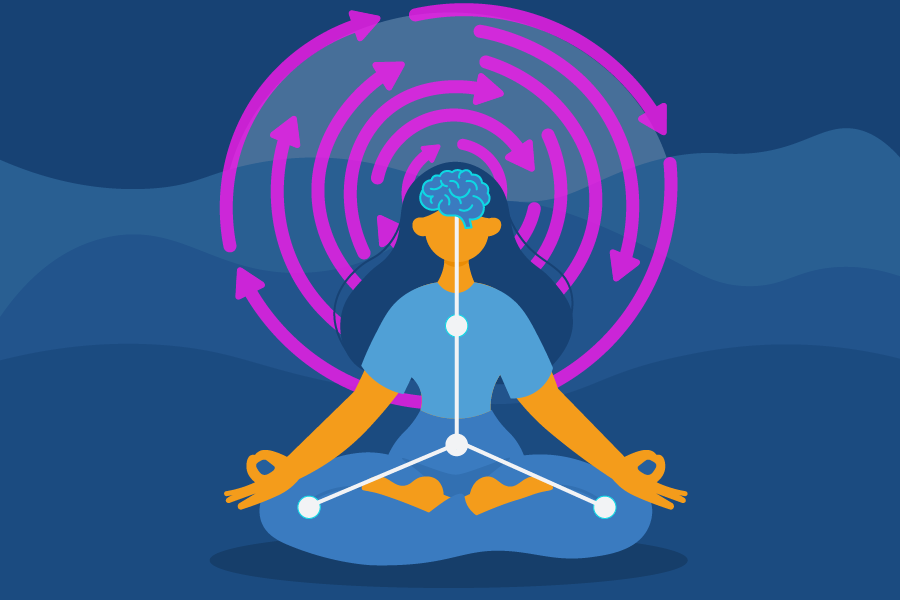What Is Suboxone?
What Is Suboxone?
Suboxone is a medication commonly used to treat opioid dependence.
Suboxone can help a person with opioid dependence and reduce the severity of withdrawal symptoms.
What Is in Suboxone?
Suboxone is made of two different drugs: buprenorphine and naloxone.
Buprenorhine is an opioid partial agonist. At low to moderate doses, it produces effects like euphoria and respiratory depression.
The properties of buprenorphine can help lower the effects of physical dependency on opioids, increase safety in overdose, and lower the potential for misuse.
Naloxone, the other drug present in suboxone, is a medicine that quickly reverses an opioid overdose.
How Does Suboxone Work?
The naloxone in Suboxone is an opioid antagonist, meaning it works by blocking the effects of opioids in both the central and peripheral nervous systems.
Opioid antagonists are the opposite of opioid agonists.
Opioid agonists affect a person’s perception of pain and can cause a person to feel pleasure.
Opioid antagonists block these effects by not allowing drugs like heroin or oxycodone to activate the pain receptors.
What Does Suboxone Feel Like?
Because suboxone acts on opioid receptors, it can create a euphoric effect.
This can lead to drug addiction, especially if used without supervision or the proper prescription from a medical professional.
Some side effects that can come with taking suboxone can include:
- Dizziness
- Blurred vision
- Drowsiness
- Back pain or muscle aches
- Nausea and vomiting
- Constipation
- Sleep problems or insomnia
How Long Should You Be On Suboxone?
The length of time a person should stay on suboxone depends on their unique needs and recommendations from a healthcare professional.
Some unique factors that will affect how long suboxone should be used includes medical conditions, how severe the addiction is, and how each person responds to the medication.
Suboxone Uses
What Is Suboxone Prescribed For?
Suboxone is prescribed to treat opioid dependence.
Occasionally, some doctors may also use suboxone for their patients who have chronic pain.
How to Take Suboxone?
It is important to follow the instructions from your doctor and the medication guide this medicine comes with.
Suboxone is often found in the form of a strip that is placed inside the mouth and dissolves within 15 to 30 minutes.
It is important to wait at least 30 minutes before you eat or drink to make sure that you do not swallow the suboxone sublingual film before it dissolves.
Suboxone may also come in sublingual tablets. Sublingual simply means that it is something placed under the tongue rather than swallowed directly.
How Long Does Suboxone Stay in Your System?
The buprenorphine in Suboxone has a long elimination half-life that lasts for 37 hours.
“Elimination half-life” is the amount of time it takes for half of a single dose of suboxone to leave the body.
Since suboxone stays in the body for a long period of time, it is crucial to follow all medical advice when taking it.
How Long Does Suboxone Block Opiates?
Suboxone typically blocks the effects of opioids, such as heroin, fentanyl, or morphine, for at least 24 hours. Sometimes it can last up to 72 hours.
This can depend on a variety of different factors, such as a person’s weight, blood pressure, age, metabolism, or history of drug use.
Suboxone Side Effects
What Are the Side Effects of Suboxone?
Common side effects of suboxone can include:
- Withdrawal symptoms, like aches, cramps, and rapid heart rate
- Headaches
- Depression and anxiety
- Difficulty sleeping
- Nausea
- Sweating
- Constipation
- Weakness
- Burning mouth syndrome
Other uncommon but possible adverse effects that can occur may include a severe allergic reaction, breathing problems, coma, liver damage, dental problems, and dependence.
Long term use can also cause changes in hormone levels, such as adrenal insufficiency.
Side effects may be worse for those with pre-existing health conditions or those who are in unique situations such as breastfeeding mothers.
This is why it is critical to always consult with a medical professional about using Suboxone.
How Does Suboxone Make You Feel?
Some side effects when a person initially takes suboxone can include headaches, dizziness, and nausea.
However, after these initial effects, suboxone can make a person feel more stable and balanced as it helps to manage uncomfortable withdrawal symptoms and reduce cravings and pain.
Does Suboxone Raise Your Heart Rate?
Increased heart rate can be a side effect of suboxone, especially in high doses.
However, this spike in heart rate rarely happens at a serious or life-threatening level.
Is Suboxone Hard on Your Stomach?
Taking suboxone on an empty stomach may increase a person’s risk of becoming nauseous or experiencing symptoms of constipation.
However, it is often recommended to wait at least 30 minutes before you eat or drink so that the medication has enough time to dissolve without being swallowed.
The gastrointestinal symptoms of suboxone can also relate to withdrawal symptoms of opioids.
When a person is going through the withdrawal process, it means the body is getting rid of the drugs from their system, causing symptoms both mentally and physically.
What Are Signs Suboxone Dose Is Too Low?
If a person is still experiencing opioid withdrawal symptoms after taking Suboxone, it might be a sign that their dose is too low.
These symptoms might involve anxiety, nausea, vomiting, or tremors.
If you think your suboxone dose might be too low, talk to your doctor to help you figure out what steps to take next.
Does Suboxone Get You High?
While suboxone is used to help treat opioid addiction, it is sometimes abused to produce a high.
Since suboxone acts on opioid receptors, people might abuse it to produce euphoric effects.
However, the naloxone present in suboxone is meant to act against opioid abuse and block the effects of opioids when used as directed.
However, if it is taken by injection or snorted, it can lead to opioid withdrawal syndrome.
Does Suboxone Cause Weight Gain?
Suboxone is not directly associated with side effects of weight gain or weight loss.
However, when a person is trying to reduce opioid use and getting past the stage of withdrawal, they might experience changes in appetite, constipation, and water retention.
These changes may indirectly lead to weight changes.
Does Suboxone Make You Tired?
Fatigue can be a side effect of suboxone.
While suboxone is not a sedative, it is taken during a very exhausting stage of recovery.
Since suboxone is used during the withdrawal stage of opioid dependence, a person might be tired because their body is going through the difficult process of eliminating opioids.
Suboxone side effects can also include insomnia, so if a person is having trouble sleeping, they will be more tired.
Suboxone Treatment
What Does Suboxone Treat For?
Suboxone is used to treat opioid use disorder and help manage opioid withdrawal symptoms in individuals over the age of 15 years.
Who Can Prescribe Suboxone?
A physician with proper DEA licensing can prescribe suboxone.
Physicians need a special license when prescribing controlled substances like suboxone for help with opioid use disorders.
Suboxone may be given in a hospital emergency department or can be given in rehab.
How to Get Prescribed Suboxone?
In order to get prescribed suboxone, those suffering from opioid addiction must be seen by a healthcare professional.
If you or a loved one are facing challenges with opioid use or opioid addiction, it is important to reach out for professional help.
Not only can medical professionals provide you with a prescription for important medications like suboxone, they can also give you tips on how to build healthy coping mechanisms while you are in recovery.
Talk to a healthcare provider or treatment center to get help for substance abuse and addiction. If you or a loved one are in immediate danger, call 911 to get help.
How Long Does It Take for Suboxone to Kick In?
It typically takes about 20 minutes to an hour to feel the effects of suboxone kick in.
The length of time it takes for suboxone to kick in can depend on a variety of different factors for each individual.
Some of the factors that will change how long it takes for Suboxone to kick in include:
- Age
- History of opioid abuse
- Metabolism
- Weight
- Lifestyle and environmental factors
- Current medications and supplements
- Severity of opioid use disorder and opioid dependence
Does Suboxone Help With Pain?
Suboxone is FDA-approved for addiction treatment but is sometimes used as an off-label drug for chronic pain.
Buprenorphine can help relieve some of the pain that comes with the withdrawal stage of opioid addiction.
It is important to note, however, that while Suboxone has some pain-relieving effects, it is not a recommended medication for pain in individuals without an opioid use disorder.
Suboxone works by binding to opioid receptors in the nervous system, which helps to alleviate pain and produce feelings of pleasure.
However, Suboxone is not as strong as other opioids since it only partially attaches to brain receptors.
Since it is a short-acting opioid, it helps to ease withdrawal symptoms without adding extra risk of addiction.
Buprenorphine, one of the ingredients in Suboxone, does stay attached to brain receptors for longer than other opioids, meaning it has a prolonged effect.
An important disclaimer is that using suboxone for pain relief without an opioid use disorder can lead to intoxication.
This is especially true when not used as directed or if taken with other substances.
Suboxone Withdrawal
How Long Does Suboxone Withdrawal Last?
Suboxone is not meant to be stopped suddenly and is usually weaned off slowly.
Stopping Suboxone cold turkey can lead to withdrawal symptoms and increase a person’s risk of relapse.
Suboxone contains buprenorphine, which is considered a long-acting opioid drug.
Because of this, withdrawal from suboxone can start anywhere from 1 to 3 days after the last dose and can last up to a month or so.
Usually, withdrawal symptoms peak in the first 72 hours.
Over the next few weeks, a person might experience both mental and physical symptoms such as depression, insomnia, and mood swings.
The length of time suboxone withdrawal lasts depends on a variety of different factors, including how long the person has been taking the drug and how high of a dose they have been taking.
What Helps With Suboxone Withdrawal?
The main strategy to help with Suboxone withdrawal is to make sure that the doses are tapered off carefully and that it is not being stopped too suddenly.
Medical professionals can also help to prescribe medications for specific symptoms, such as antihistamines to help with insomnia.
What Are Symptoms of Suboxone Withdrawal?
Common symptoms of suboxone withdrawal can include:
- Aches and pains
- Nausea and vomiting
- Sweating
- Chills
- Goosebumps
- Tremors
- Cramps or diarrhea
It is important to note that if you are taking suboxone to treat opioid use disorder, the withdrawal symptoms of suboxone would likely be less severe compared to withdrawal symptoms of stronger opioids.
How to Get Off Suboxone?
Suboxone is meant to be tapered off, which means your doctor or other healthcare professional will help you slowly decrease the dosage of the drug over time to decrease the risk of withdrawal symptoms.
Can You Overdose on Suboxone?
Yes, it is possible to overdose on Suboxone. However, it is less likely to overdose on Suboxone than on other opioids.
Certain medications and substances can interact with suboxone, putting a person at a higher risk of overdose.
Drugs that can interact with suboxone include benzodiazepines, other opioids, sleeping pills, seizure medications, antipsychotics, and others.
It is important to talk with your healthcare provider if you are taking or planning to take suboxone to make sure it does not interact with any medications that you might be taking.
Suboxone Vs. Methadone
What Is Methadone?
Methadone is a medication that is also used to help treat opioid use disorder (OUD).
Methadone is FDA-approved to treat opioid use disorder.
The Federal Drug Administration has also approved the use of Methadone for chronic pain management.
What Are Some Side Effects of Methadone?
Side effects of methadone can include:
- Restlessness
- Slowed breathing
- Nausea
- Vomiting
- Sweating
- Itchy skin
- Constipation
Is Suboxone the Same as Methadone?
While both suboxone and methadone can be used to treat opioid use disorder, they are not the same.
One of the differences between the two is that methadone is an opioid agonist. Suboxone contains buprenorphine, an opioid partial agonist, and naloxone, which is an opioid antagonist.
Additionally, methadone has a higher risk for misuse, as the naloxone in suboxone helps to decrease the risk for misuse by blocking the effects of opioids.
Some of the similarities between the two are that both medications contain synthetic opioids, both can help manage opioid withdrawal symptoms, and both can help a person work toward achieving addiction treatment goals.
Is Suboxone Better for Pain Than Methadone?
Methadone is approved for use for both OUD and chronic pain, whereas suboxone is only approved to help treat OUD.
The effectiveness of medication is dependent upon the individual’s unique needs, and not everyone responds to medications the same way, so it is difficult to say whether one is better than the other.
Buprenorphine Vs. Suboxone
What Is Buprenorphine?
According to the Substance Abuse and Mental Health Services Administration (SAMHSA), buprenorphine is the first medication used to treat opioid use disorder.
Buprenorphine is approved by the FDA to treat acute and chronic pain and opioid dependence.
Is Buprenorphine the Same as Suboxone?
Buprenorphine is the active ingredient in suboxone.
Suboxone contains both buprenorphine and naloxone.
Sublocade Vs. Suboxone
What Is Sublocade vs Suboxone?
Sublocade contains only buprenorphine, whereas suboxone contains both buprenorphine and naloxone.
Medication-assisted treatment may utilize either of these medications.
Another difference between the two is that suboxone is usually taken as a sublingual film, whereas sublocade is an abdominal injection.
Can You Take Suboxone on Sublocade?
Suboxone and sublocade are not prescribed at the same time.
These drugs are given for different stages of treatment for opioid use disorder.



